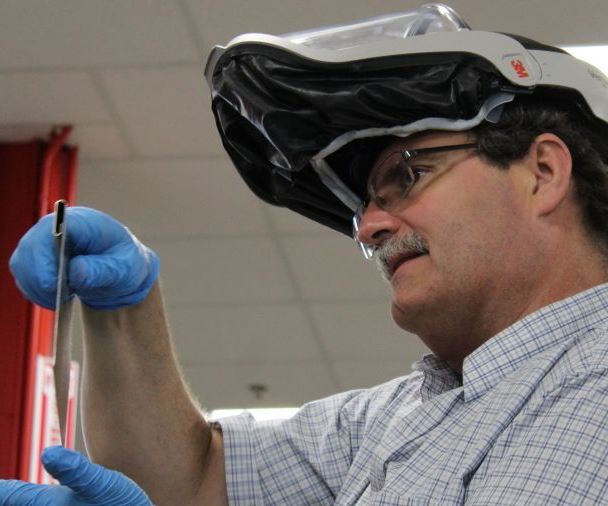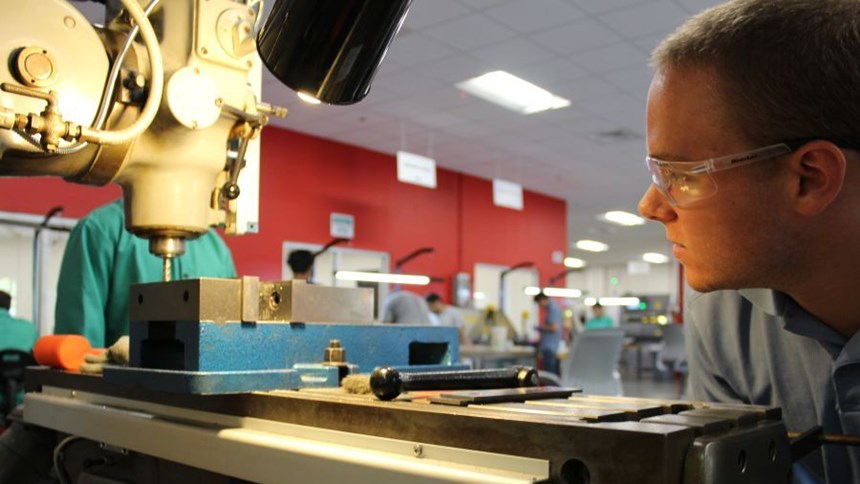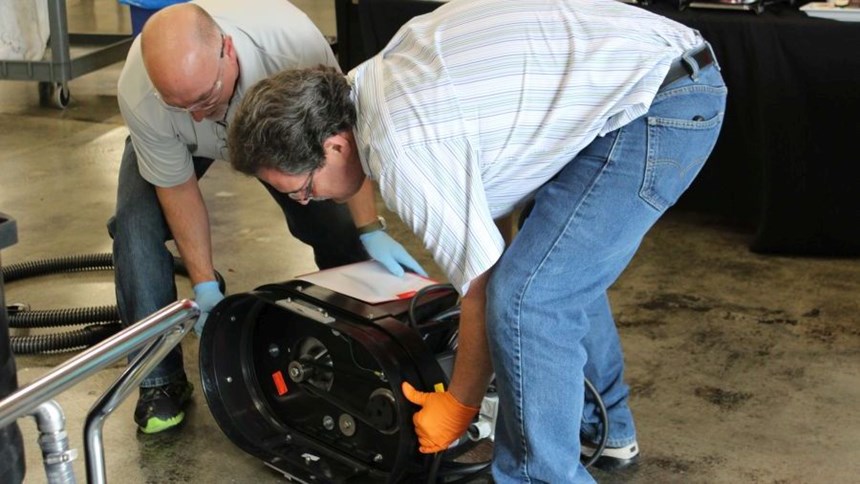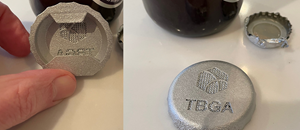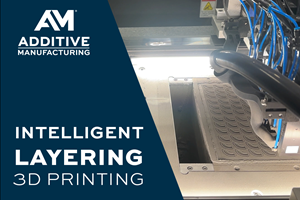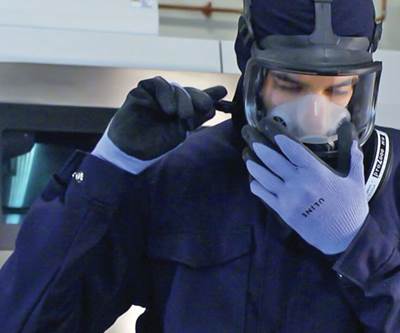Safety Hazards in Additive Manufacturing
The number-one thing a company can do to protect its AM investment and not interrupt production is develop a comprehensive safety policy specifically for additive.
Since our last update on the UL Additive Manufacturing Competency Center (UL AMCC), 100 engineers, ranging from employees of Fortune 500 companies to two guys buying a machine to take a run at starting a 3D printing business, have taken the Advanced Training on Metal Part Production course at the Louisville, Kentucky, facility.
The training is hands-on, and classes are limited to 10 seats. Each class runs for five days, during which students perform between six and eight builds. This process includes design setup, design optimization, machine setup, part production, postprocessing, part inspection, testing, validation, and facility and process safety. The course covers metal AM from A to Z, but safety is the priority.
Ed Tackett, director of educational programs at UL AMCC, says his team gets hit with a safety question at least once a week from industry. There’s a recognition of the need to be safe, but the real question is what does it take? UL AMCC seeks to ensure students know the risk specific to AM and how to mitigate those risks.
“Believe it or not, companies are not being safe,” Tackett explains. “We had a group come in for training, and after the initial day’s safety lecture, they immediately called their company to shut down the AM lab. They had no idea some of these dangers existed.”
Jon Walker, CMTSE, an area sales manager for EOS of North America who took the course, agrees, “UL’s safety-first approach allows the trainee to take a pause from focusing only on making a good part the moment the machine is installed, and to begin fully understanding the unique safety requirements of working with metal powder.”
Here are a few examples of often-overlooked safety concerns:
Material Behavior
How a material behaves under certain conditions is a crucial safety consideration. For example, condensate, which is the smoky emission created when the laser is firing, has an extremely small particle size. This gives it tremendous surface area and the ability to ignite with very little energy to cause ignition. The slightest spark, often caused by static electricity, will cause it to ignite. So, care should be taken when changing filters and working in the system.
“There are very specific procedures to mitigate this risk, passivate the dangerous material and protect the operator from any potential exposures. For example, using checklists, two-person integrity and the right safety gear stationed at the point of your work,” says Tackett.
UL AMCC teaches two-person integrity as part of servicing the machine, meaning that one person performs the servicing while the other works down a checklist. For example, are you grounded? Check. Is your respirator on and attached properly? Check.
“This is much like a pilot and co-pilot prepping to fly a plane. It ensures each step is completed and verified,” says Paul Bates, general manager of the UL AMCC.
Every metal AM machine should have a bucket of sand by it to passivate dangerous material (make it inert), according to Bates. It can also be used to create a barrier around a fire before extinguishing it with a Class D fire extinguisher. The sand can even put out a small metal fire, though fire extinguishers are the best method.
Although vendors are recommending the use of sand, they are not specifying whether this means beach sand, playground sand or concrete mixing sand. This is important because the effect of the sand on the metal materials in AM depends on the type of sand used. A sand that has moisture in it rapidly oxidizes with the aluminum powder, for example, hydrogen gas is created, which can explode and cause a fire.
UL AMCC recommends ASTM C-33 sand. It is stored dry, is readily available and since it has a standard, it is easy to specify at a facility. The particle distribution of this sand is consistent and has a wide range of particles, making it more effective in many cases, according to Tackett.
“Many service providers that I speak with are always interested in small safety-related items, like the sand requirements for the filter passivation. UL has taken the time to identify the proper sand that meets fire safety requirements in the United States and where to source it. I share that with nearly everyone I talk to,” says Walker.
Dangerous Exposure
Bates has learned that most people think they only need minimal protection when working with metal AM. UL AMCC has learned of vendors telling companies to use a Tyvek suit for protection, which are common for household painting. “First, they are not fireproof and second, they are breathable. This means there are pores into which powdered metal can get trapped, so you are essentially wearing a white flammable suit covered in metal powder,” says Bates. “People think they are protected and it’s actually the complete opposite.”
How do you put out a metal fire if it spreads to a person? Not with water—hitting a titanium fire with water causes it to rain fire, according to Tackett—and not with a fire extinguisher. UL AMCC’s research has shown that the best method is to use a fire blanket. This sounds simple, but metal additive manufacturers who don’t know won’t have a fire blanket on hand.
The same goes for face masks. The ones commonly used to service AM machines are also those used for sanding or painting. People are not taking into account how well they put the masks on, how long they are going to wear them, what activity they are doing and how dirty they are. Plus, these masks are also made of breathable paper and can hold metal powder. “If there is a flash incident, you are wearing a flaming mask on your face,” says Tackett.
UL AMCC exceeds accepting safety levels when it comes to respirators. Tackett explains that paper face covering respirators at N95 are good for 95 percent of AM metal material, but UL AMCC chooses to use positive-pressure filter systems with N100 filters that provide 99.97 percent protection, which is the maximum protection for this type of exposure.
UL AMCC tends toward excessive protection, defined as “going beyond adequate,” because they believe the safer the user, the more sustainable he or she will be as an employee.
“The full results of being exposed to these materials has not been determined over a long period of time,” Bates says. “Metal materials in powders as small as 5 microns can penetrate your skin, and do possible damage that might not become evident for years to come.”
Waste Management
Buyers of metal AM machines typically receive basic training on the machine, but not much on the periphery equipment, such as the wet separator, for example.
“Companies are not servicing the wet separator because they think it’s only water,” Tackett says. “So the metal powder settles on the bottom. Much of the water can evaporate in your wet separator, so if you haven’t serviced it in a month, you may be running a wet separator with no water in it, which then becomes a fire bomb.”
Essentially, the inside of the vacuum will aerosol the powder as it sucks it in, the electric motor provides the ignition source and the powder can spark, smolder, burn or even explode.
The type of waste created should also be considered. For example, there is a material used in AM today that has chromium in it, which puts it on the EPA’s list of toxic substances. The waste stream for this material must be more carefully controlled.
The quantity of waste is another area of concern. The industry has been so small for so long, but now that it is gaining a footprint, a large amount of waste is being generated and disposal can come at a high price.
“Each week when you service your wet separator, it discharges at least 22 gallons of waste water. In one year, one vacuum can produce 1,144 gallons of waste water. In some parts of the country, it can cost up to $6,000 to dispose of a single 55-gallon drum. Now imagine 21 drums at $6,000. That equals $124,800,” says Bates.
Regulatory agencies are now looking at facilities to make sure they have the correct procedures and certifications in place for working in metal AM. However, an ongoing challenge is that regulators themselves don’t fully understand the technology, making the promotion of user safety training all the more important.
“Training is relatively expensive, so companies push back on the cost and employees being out, but did you know that with one barrel of wet separator waste you cover the cost of the course?” questions Bates.
When students leave the UL AMCC metals course, they receive a certification stating that they participated in the training. “Although in five days we are not going to teach someone how to make perfect parts every time, we are going to help build their confidence, provide an understanding of the environmental, health and safety issues, and give them a sound foundation of the knowledge that it takes to create robust certifiable parts off an AM machine,” says Bates.
Related Content
A Framework for Qualifying Additively Manufactured Parts
A framework developed by The Barnes Global Advisors illustrates considerations and steps for qualifying additively manufactured parts, using an example familiar to those in AM: the 3D printed bottle opener.
Read More8 Cool Parts From Formnext 2023: The Cool Parts Show #65
New additive manufacturing technologies on display at Formnext were in many cases producing notable end-use components. Here are some of the coolest parts we found at this year’s show.
Read MoreVideo: Intelligent Layering Metal 3D Printing at 3DEO
Contract manufacturer 3DEO delivers metal parts using Intelligent Layering, a binder jetting-like 3D printing process the company developed and operates internally. Here’s how it works.
Read MoreUnderstanding PEKK and PEEK for 3D Printing: The Cool Parts Show Bonus
Both materials offer properties desirable for medical implants, among other applications. In this bonus episode, hear more from Oxford Performance Materials and Curiteva about how these companies are applying PEKK and PEEK, respectively.
Read MoreRead Next
Additive Manufacturing Is Changing the Rules on Safety
Bringing safety to the forefront helps to mitigate the risk of additive technology within a manufacturing environment.
Read More3D Printed Polymer EOAT Increases Safety of Cobots
Contract manufacturer Anubis 3D applies polymer 3D printing processes to manufacture cobot tooling that is lightweight, smooth and safer for human interaction.
Read MoreCrushable Lattices: The Lightweight Structures That Will Protect an Interplanetary Payload
NASA uses laser powder bed fusion plus chemical etching to create the lattice forms engineered to keep Mars rocks safe during a crash landing on Earth.
Read More

